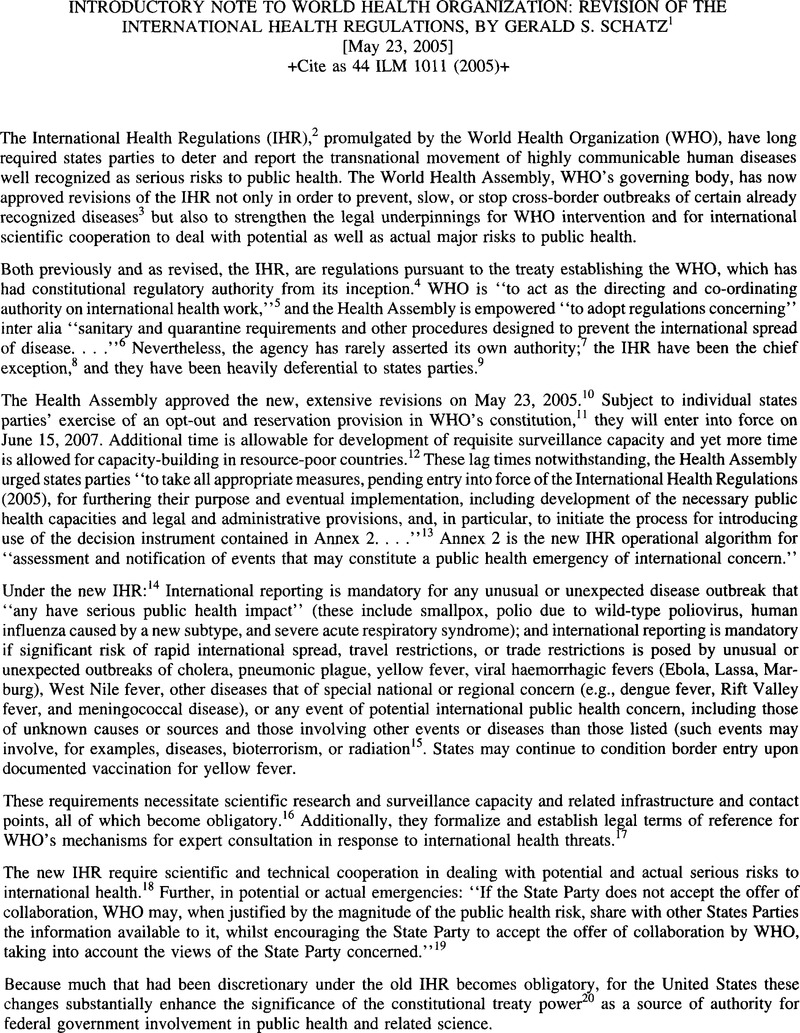No CrossRef data available.
Article contents
World Health Organization : Revision of the International Health Regulations by Gerald Schatz
Published online by Cambridge University Press: 27 February 2017
Abstract

- Type
- Treaties and Agreements
- Information
- Copyright
- Copyright © American Society of International Law 2005
References
1 Gerald S. Schatz, of the District of Columbia Bar, is Assistant Professor in the Center for Ethics and Humanities in the Life Sciences, of the Michigan State University College of Human Medicine. He developed and teaches the joint seminar in International Law and Ethics of Human Subjects Research for the Michigan State University Colleges of Law and Human Medicine. He is a former visiting scholar of the Georgetown University Center for Clinical Bioethics.
2 International Health Regulations, with Appendices. Adopted at Boston July 25, 1969; entered into force January 1,1971. 21 UST 3003; TIAS 7026; 764 UNTS 3. Additional regulations amending articles 1, 21, 63 to 71, 92, and appendix 2 of the international health regulations. Adopted at Geneva May 23, 1973; entered into force January 1, 1974. 25 UST 197; TIAS 7786. Additional amendments to the international health regulations. Adopted at Geneva May 20, 1981; entered into force January 1, 1982. 33 UST 4436; TIAS 10314; World Health Organization, International Health Regulations (1969) (3d an-not. ed., updated 1995),available at http://www.who.int/csr/ ihr/current/en/print.html.
3 Id.,passim. The old IHR were directed primarily against cholera, plague, yellow fever, and smallpox and to a lesser extent dealt with aspects of malaria, plague, and rodent and insect vectors for these several diseases.See also World Health Organization, Press Release, World Health Assembly adopts new International Health Regulations: New rules govern national and international response to disease outbreaks (May 23,2005),available at http://www.who.int/mediacentre/news/ releases/2005/pr_wha03/en/print.html
4 Constitution of the World Health Organization. Done at New York July 22, 1946; entered into force April 7, 1948; for the United States June 21, 1948. 62 Stat. 2679; TIAS 1808; 4 Bevans 119; 14 UNTS 185.
5 WHO const, art. 2(a).
6 WHO const, art. 21(a).
7 Frederic L. Kirgis, Jr., International Organizations in Their Legal Setting (2d. ed., 1993), 315-316.
8 Id.
9 David P. Fidler, International Law and Infectious Diseases (1999), 63-65.
10 Revision of the International Health Regulations, 58th World Health Assembly, WHA58.3, Agenda item 13.1 (23 May 2005),available at http://www.who.int/csr/ihr/en/.
11 WHO const, art.22.
12 International health regulations, with appendices. Adopted at Geneva May 23, 2005, art. 5.
13 Revision of the International Health Regulations, WHO resolution at 1 5(4).
14 Revision of the International Health Regulations, Annex 2.
15 Revision of the International Health Regulations, 58th World Health Assembly, resolution of approval, at\ 4.
16 Revision of the International Health Regulations, Annex 1.
17 Revision of the International Health Regulations, art. 13 f 3, arts, 47-53.
18 Revision of the International Health Regulations, art. 44, e.g.
19 Revision of the International Health Regulations, art. 9 1 4.
20 U.S. Const, art. 6, cl. 2, art. 3, § 2. In the U.S. federal-state system, with a national government of limited powers, except for the treaty-derived obligation to comply with the IHR the national government's constitutional powers relating to public health are primarily the powers to tax and spend and the power to regulate commerce.See Lawrence O. Gostin, ed., Public Health Law and Ethics: A Reader (2002), xxi-xxii. For U.S. implementation of the old IHRsee 42 U.S.C. 243, 264-272 (2002) and 42 C.F.R. pt. 71 (2004).
* State: (1) whether the person recovered, is still ill or died; and (2) whether the person is still on board, was evacuated (including the name of the port or airport), or was buried at sea.
1 See document A58/4.
2 Document A58/41 Add.2.
3 An informal working group met during the second session of the Intergovernmental Working Group and recommended changes to this document which WHO will transmit to the International Civil Aviation Organization for appropriate consideration.




